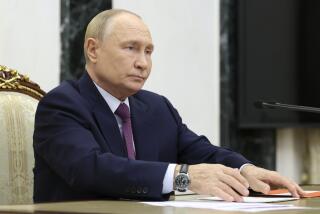Kremlin Shift on ‘Star Wars’ Tests Indicated
- Share via
GENEVA — The Soviet Union has proposed to the United States that any agreement reached on cuts in long-range strategic nuclear weapons would automatically lapse if either side were to begin deploying defense systems in outer space, it was learned here at the nuclear arms control talks.
The Soviets apparently are pulling back somewhat from their diplomatic effort to halt the American Strategic Defense Initiative program (“Star Wars”) in its present stage of development and testing. But sources here, who requested anonymity, said that the new Moscow proposal would shift the focus to blocking any deployment of an SDI system.
However, while this seems to be the Soviet intention, sources say that the wording of the new proposals from Moscow is imprecise and open to conflicting interpretation. An American attempt to clarify exactly what the Soviets mean will therefore probably be an important point of the next meeting between Secretary of State George P. Shultz and Soviet Foreign Minister Eduard A. Shevardnadze in Moscow, scheduled to begin Oct. 22.
The Soviet proposal, submitted to the Americans at the Shultz-Shevardnadze meeting in Washington two weeks ago, stipulates that a 50% cut in strategic nuclear arms would be conditional on a 10-year extension of the 1972 Anti-Ballistic Missile Treaty; at the end of that period, the new limits on strategic weapons on both sides would automatically lapse in the event of any exceptional or decisive developments or changes in the field of anti-ballistic missile defense.
The proposal does not spell out precisely what the Soviets would consider to be a “decisive change” after 10 years that might then, in effect, open up a new race in strategic missiles. But SDI deployment clearly would fall into this category. The Soviets also presumably will insist on a “narrow interpretation” of the 1972 treaty, which would place limits on the weapons-testing phase of the SDI development program.
These are the points that will need to be clarified in Moscow. Nevertheless, there appear to be sufficient signs of flexibility in the new Soviet position to encourage hopes that the outlines of a deal on strategic weapons could soon be reached to follow the wrap-up of a treaty for eliminating intermediate-range nuclear weapons worldwide.
President Reagan is already on record that the United States would not proceed with deployment of any strategic defense system in outer space without consultation with its allies. He is also on the record with an offer to share the benefits of space technology with the Soviet Union and begin deployment of any SDI system only if the two sides were unable to reach any cooperative agreement.
U.S. Side Encouraged
At the Washington meeting, the American side was encouraged by indications that the Soviets are no longer pressing their long-held position that SDI development had to be confined to “laboratory testing.” The Soviets, it is speculated here by sources involved in the nuclear talks, may have realized that their demands would also be limiting themselves in their research on space defense.
Nevertheless, if the two sides were to agree to extend and abide by the 1972 ABM treaty for another 10 years, they would also have to agree on precisely how that treaty is to be interpreted and what its clauses mean. As a starter, sources here said, would this mean that the Soviet radar installation being built at Krasnoyarsk in Siberia has to be abandoned, or is it within the terms of the 1972 treaty?
On the other hand, the sources pointed out, the 1972 treaty permitted each side to build three ballistic missile sites. But once the treaty was signed, the United States decided that ABM systems would not be cost effective and that war could be prevented through the deterrent threat of massive attack by strategic missiles.
The sources said that the Soviets may now assume that if they were to agree to a 50% missile cut, but link this to a clause that would in effect ban any deployment of space weapons, then the SDI development would never go much beyond a testing phase anyway and would slowly be abandoned by the United States on the grounds of cost effectiveness.
More to Read
Sign up for Essential California
The most important California stories and recommendations in your inbox every morning.
You may occasionally receive promotional content from the Los Angeles Times.













